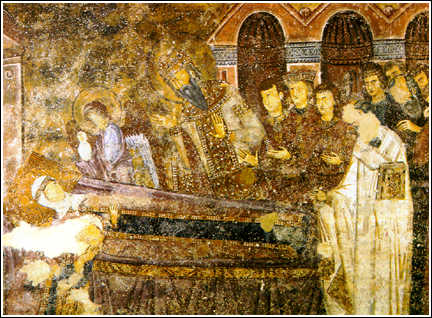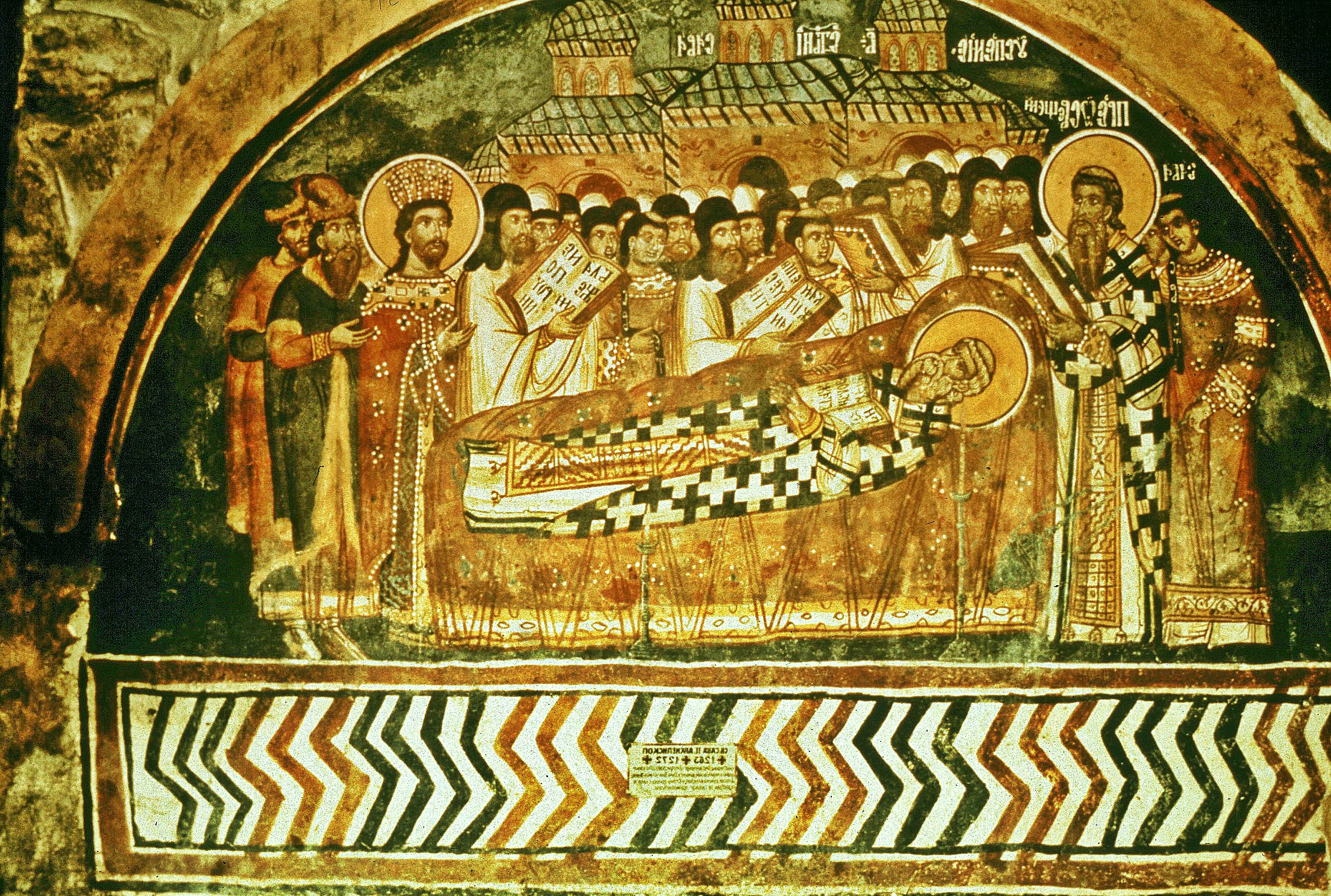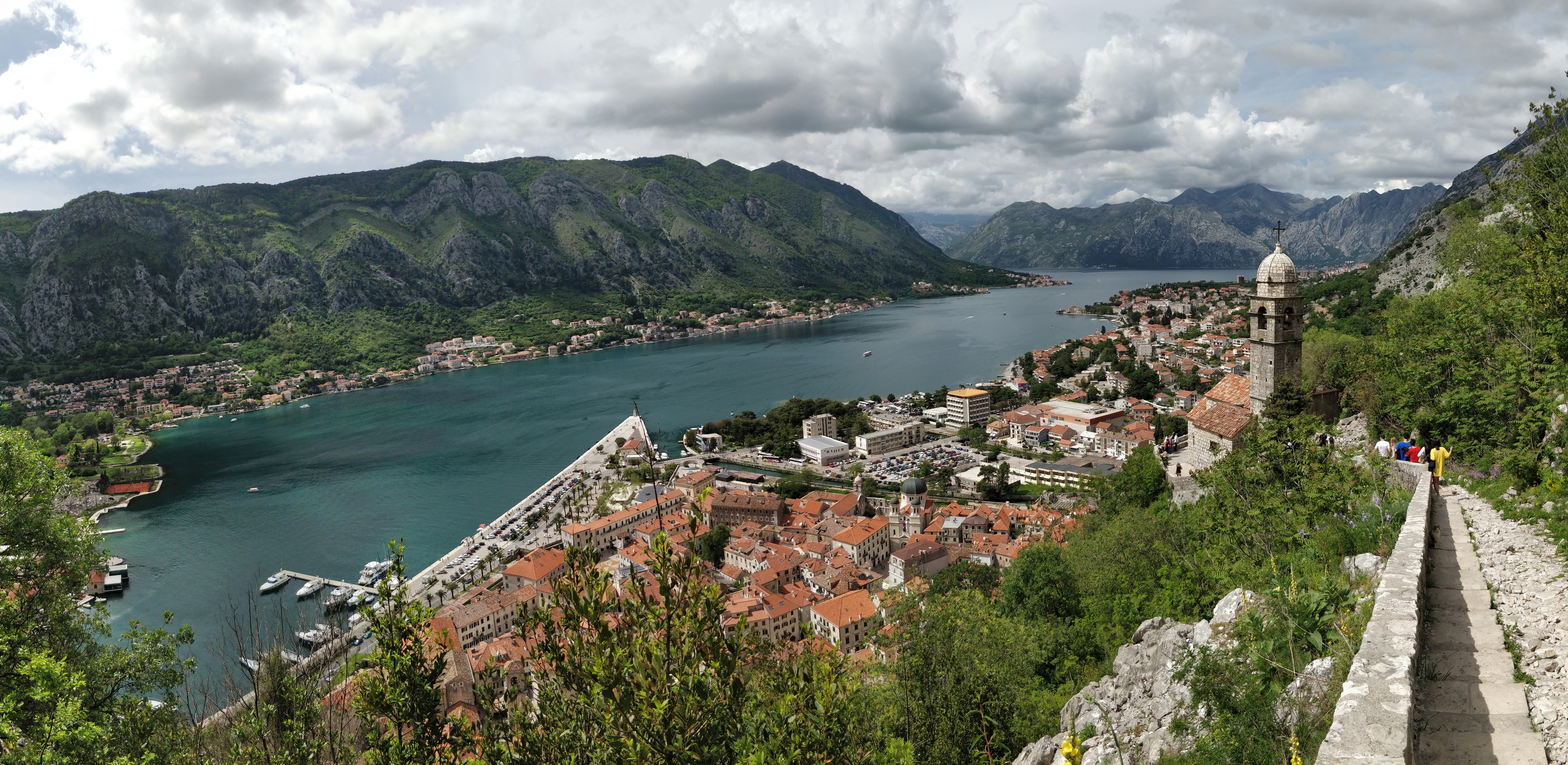|
Eudokia Angelina
Eudokia Angelina (or Eudocia Angelina) ( gr, Ευδοκία Αγγελίνα, sr, Evdokija Anđel; around 1173–died , or later) was the consort of Stefan the First-Crowned of Serbia from c. 1190 to c. 1200. She later remarried, to Alexios V Doukas, who briefly ruled as Emperor of Byzantium in 1204. She was a daughter of Alexios III Angelos and Euphrosyne Doukaina Kamatera. Life Eudokia first married Stefan, the second son of Stefan Nemanja, Grand Župan of Serbia. The marriage was arranged by her uncle, the emperor Isaac II Angelos, around 1190, while her father was in exile in Syria. In 1196, on her father-in-law's retirement to a monastery, Eudokia's husband became ruler of Serbia. According to the Byzantine historian Nicetas Choniates, Stefan and Eudokia quarrelled and separated, accusing one another of adultery, and therefore in 1200 or 1201, Eudokia was banished from Serbia. Eudokia fled on foot with only the clothes on her back, seeking refuge at the court of Stefan's bro ... [...More Info...] [...Related Items...] OR: [Wikipedia] [Google] [Baidu] |
List Of Roman And Byzantine Empresses
This is a list of Roman and Byzantine empresses. A Roman empress was a woman who was the wife of a Roman emperor, the ruler of the Roman Empire. The Romans had no single term for the position: Latin and Greek titles such as '' augusta'' (Greek αὐγούστα, ''augoústa'', the female form of the honorific ''augustus'', a title derived from the name of the first emperor, Augustus), ''caesarea'' (Greek καισᾰ́ρειᾰ, ''kaisáreia'', the female form of the honorific ''caesar'', a title derived from the name of Julius Caesar), βᾰσῐ́λῐσσᾰ (''basílissa'', the female form of '' basileus''), and ''αὐτοκράτειρα'' (''autokráteira,'' Latin ''autocratrix'', the female form of autocrator), were all used. In the third century, ''augustae'' could also receive the titles of ''māter castrōrum'' "mother of the castra" and ''māter patriae'' "mother of the fatherland". Another title of the Byzantine empresses was εὐσεβέστᾰτη αὐγο� ... [...More Info...] [...Related Items...] OR: [Wikipedia] [Google] [Baidu] |
Repudiation (marriage)
Repudiation is the formal or informal act by which a husband renounces his wife in certain cultures and religions. For example: * In Islam, a talaq divorce allows a woman or man to divorce their spouse (in Arabic, talaq), otherwise known as the formula of repudiation. * In Babylonian law a husband could repudiate his wife, at the cost of returning the dowry. * Repudiation is also a concept that existed in the Roman law * In India, Section 13(2)(iv) of the Hindu Marriage Act and Section 2(vii) of the Dissolution of Muslim Marriages Act, 1939 gave young wives the option, within time limits, while Section 3(3) of the Prohibition of Child Marriage Act, 2006 gave both husbands and wives the choice, as well as a little more time to exercise it. Inconsistencies in the law are an issue in repudiation of marriage due to different age requirements. See also * Divorce Divorce (also known as dissolution of marriage) is the process of terminating a marriage or marital union. Divo ... [...More Info...] [...Related Items...] OR: [Wikipedia] [Google] [Baidu] |
1170s Births
117 may refer to: * 117 (number) *AD 117 * 117 BC * 117 (emergency telephone number) * 117 (MBTA bus) * 117 (TFL bus) * 117 (New Jersey bus) *'' 117°'', a 1998 album by Izzy Stradlin *No. 117 (SPARTAN-II soldier ID), personal name John, the Master Chief (Halo) See also * List of highways numbered 117 *Tennessine, synthetic chemical element with atomic number 117 *11/7 (other) 11/7 may refer to: *November 7 (month-day date notation) *July 11 (day-month date notation) **2006 Mumbai train bombings, held on 11 July *11 shillings and 7 pence in UK predecimal currency See also *117 (other) 117 may refer to: *117 (n ... * * 17 (other) * B117 (other) * F-117 (other) {{Numberdis ... [...More Info...] [...Related Items...] OR: [Wikipedia] [Google] [Baidu] |
Anna Dandolo
Anna Dandolo ( sr, Ana Dandolo / Ана Дандоло; 1217–1258) was a Venetian noblewoman who became Queen of Serbia as the third wife of King Stefan the First-Crowned, founder of the Serbian kingdom. She was crowned with Stefan in 1217, and she held this title until his death on 24 September 1228. She was the granddaughter of Enrico Dandolo, Doge of Venice. King Stefan Uroš I was her son. Life Origin Anna was born in Venice, Republic of Venice, on an unknown date, as a member of the House of Dandolo, which ruled in Venice. She was the daughter of Rainero Dandolo, Vice-Doge of Venice, and Procurator of San Marco. Her paternal grandfather was Enrico Dandolo, Doge of Venice, who had earlier made incursions into Zadar (1202) and Constantinople (1204). In 1209, her father was killed in battle against the Genoese during the conquest of Candia. Queen of Serbia In about 1216 or 1217, she married Stefan, the Grand Prince of Serbia and son of Stefan Nemanja, in a magnificen ... [...More Info...] [...Related Items...] OR: [Wikipedia] [Google] [Baidu] |
List Of Serbian Consorts
This is a list of consorts of Serbian monarchs during the history of Serbia. Middle Ages Princess- and Grand Princess consorts (–1217) Queen consorts Nemanjić dynasty (1217–1365) Empress consorts Nemanjić dynasty (1346–71) Magnate era Mrnjavčević family (1365–95) Lazarević family (1371–1402) Despotess consorts Lazarević dynasty (1402–27) Branković dynasty (1427–59) Kotromanić dynasty (1459) Despotess consorts (in exile) Branković dynasty (1459–1504) Berislavić dynasty (1504–36) Bakić family (1537) Modern Consort of the Grand Leader Karađorđević dynasty (1804–13) Princess consorts Obrenović dynasty (1815–42) Karađorđević dynasty (1842–58) Obrenović dynasty (1858–82) Queen consorts Obrenović dynasty (1882–1903) Queen consort of Serbs, Croats and Slovenes Karađorđević dynasty (1918–29) Queen consorts of Yugoslavia Karađorđević dynasty (1929–45) See also * List of princesses of Serbia Re ... [...More Info...] [...Related Items...] OR: [Wikipedia] [Google] [Baidu] |
Saint Anastasija
Ana ( sr-Cyrl, Ана); 1196–d. June 22, 1200) was the princess consort of the Serbian Principality as the wife of Stefan Nemanja (r. 1166–1196). She was of noble descent. Ana took monastic vows in 1196 and was baptized ''Anastasia'', after Anastasia of Sirmium. She is venerated by the Serbian Orthodox Church as Saint Anastasija ( sr, / ) with her feast day on June 22 (Julian calendar). Theories of origin Her origins have never been concluded. The oldest source mentioning her origin was Domentijan (c. 1210 – after 1264), who said of her: "a great princess, daughter of the Byzantine Emperor Romanos", only Romanos IV Diogenes ruled 1068–71, making this genealogy impossible. * Mavro Orbini, writing in 1601, mentioned her as a daughter of the Bosnian Ban. He perhaps mixed her up with the wife of Prince Miroslav, who was the sister of Ban Kulin. However this is not supported by any sources.Predrag Puzović 1998, ch. Lepa Ana, kći bosanskog bana * Jovan Rajić thought ... [...More Info...] [...Related Items...] OR: [Wikipedia] [Google] [Baidu] |
List Of Byzantine Emperors
This is a list of the Byzantine emperors from the foundation of Constantinople in 330 AD, which marks the conventional start of the Byzantine Empire, Eastern Roman Empire, to Fall of Constantinople, its fall to the Ottoman Empire in 1453 AD. Only the emperors who were recognized as legitimate rulers and exercised sovereign authority are included, to the exclusion of junior co-emperors (''symbasileis'') who never attained the status of sole or senior ruler, as well as of the List of Byzantine usurpers, various usurpers or rebels who claimed the imperial title. The following list starts with Constantine the Great, the first Christian emperor, who rebuilt the city of Byzantium as an imperial capital, Constantinople, and who was regarded by the later emperors as the model ruler. It was under Constantine that the major characteristics of what is considered the Byzantine state emerged: a Roman polity centered at Constantinople and culturally dominated by the Greek East and Latin West, ... [...More Info...] [...Related Items...] OR: [Wikipedia] [Google] [Baidu] |
Komnena Nemanjić
Komnena Nemanjić ( sr-cyr, Комнена Немањић; fl. 1208–1215) was the Duchess consort of Dimitri Progoni, the albanian ''megas archon'' of Kruja, and later Gregory Kamonas, the ''archon'' of Elbasan. She was the daughter of Serbian King Stephen II Nemanjić (r. 1196–1228).REDAKCIJA ZA ISTORIJU CRNE GORE: ISTORIJA CRNE GORE, book 2, tom 1, Titograd, 1970, pp. 8-9. Life Komnena was born to King Stephen II and his wife Eudokia Angelina, and was thus a granddaughter of Emperor Alexios III Angelos. She had three brothers: Stephen Radoslav (r. 1228–1233), Stephen Vladislav I (r. 1233–1243) and Predislav (the third Serbian Archbishop as ''Saint Sava II'', after uncle Sava). She married Dimitri in 1208, and a brief alliance was formed between Serbia and Arbanon amidst conflicts with the Republic of Venice. After Dimitrii died in 1215, the power was left to Komnena, who shortly afterwards married Greco-Albanian lord Gregory Kamonas. He assumed control over Kruja ... [...More Info...] [...Related Items...] OR: [Wikipedia] [Google] [Baidu] |
Sava II
Saint Sava II ( sr, Свети Сава II / ''Sveti Sava II''; 1201–1271) was the third archbishop of the Serbian Orthodox Church, serving from 1263 until his death in 1271. He was the middle son of King Stefan the First-Crowned of the Nemanjić dynasty and his Byzantine wife Eudokia Angelina. He had two brothers, Stefan Radoslav and Stefan Vladislav, and a sister, Komnena. Predislav took the monastic name of ''Sava'', after his uncle, Saint Sava, the first Serbian archbishop. The Serbian Orthodox Church celebrates him as a saint and his feast-day is 21 February. Born as Predislav ( sr-cyr, Предислав) in 1198, he was the middle son of King Stefan the First-Crowned and Eudokia Angelina. He had brothers Stefan Radoslav (b. 1192), Stefan Vladislav (b. 1198), and half-brother Stefan Uroš I (b. 1223). He also had two sisters, Komnena being the only one whose name is known. King Stefan the First-Crowned, who had become ill, took monastic vows and died in 1227. Radosla ... [...More Info...] [...Related Items...] OR: [Wikipedia] [Google] [Baidu] |
Stefan Vladislav
Stefan Vladislav ( sr-cyr, Стефан Владислав, ; – after 1264) was the King of Serbia from 1234 to 1243. He was the middle son of Stefan the First-Crowned of the Nemanjić dynasty, who ruled Serbia from 1196 to 1228. Radoslav, the eldest son of Stefan the First-Crowned, was ousted by the Serbian nobility due to increasing Epirote influence through his marriage alliance to Theodore Komnenos Doukas; thus Vladislav became his successor. He is celebrated as Saint Vladislav by the Serbian Orthodox Church. During Vladislav's reign, his uncle Archbishop Sava went on a pilgrimage and died in Bulgaria while on his way home. Vladislav obtained the remains and buried them in the Mileševa monastery, which he had built intended to be his burial place. Serbia was politically aligned with Bulgaria at the time, since Vladislav was married to Beloslava, the daughter of Ivan Asen II. Vladislav secured Hum, a maritime province under attack by Hungarian crusaders. Afte ... [...More Info...] [...Related Items...] OR: [Wikipedia] [Google] [Baidu] |
Stefan Radoslav
Stefan Radoslav ( sr-cyr, Стефан Радослав; 1192 – after 1235), also known as Stephanos Doukas ( gr, Στέφανος Δούκας), was the King of Serbia, from 1228 to 1233. Family Stefan was the eldest son of Stefan Nemanjić (r. 1196–1228), by his first wife Eudokia Angelina, daughter of Byzantine Emperor Alexios III Angelos (r. 1195–1203) and Euphrosyne Doukaina Kamaterina. He reportedly had two unnamed sisters, the first of whom married first the Albanian prince Dhimitër Progoni, and secondly the Greco-Albanian lord Gregorios Kamonas, while the second married the ''sebastokrator'' Alexander Asen, whom George Acropolites identifies as a son of Tsar Ivan Asen I of Bulgaria (r. 1189–96). It is uncertain if his mother was Maria or Helena, respectively the first and second wife of Ivan Asen I. Alexander was the father of Kaliman II of Bulgaria (r. 1256). According to the historian John Van Antwerp Fine, Jr., Eudokia was repudiated on grounds of ad ... [...More Info...] [...Related Items...] OR: [Wikipedia] [Google] [Baidu] |
Corinth
Corinth ( ; el, Κόρινθος, Kórinthos, ) is the successor to an ancient city, and is a former municipality in Corinthia, Peloponnese, which is located in south-central Greece. Since the 2011 local government reform, it has been part of the municipality of Corinth, of which it is the seat and a municipal unit. It is the capital of Corinthia. It was founded as Nea Korinthos (), or New Corinth, in 1858 after an earthquake destroyed the existing settlement of Corinth, which had developed in and around the site of ancient Corinth. Geography Located about west of Athens, Corinth is surrounded by the coastal townlets of (clockwise) Lechaio, Isthmia, Kechries, and the inland townlets of Examilia and the archaeological site and village of ancient Corinth. Natural features around the city include the narrow coastal plain of Vocha, the Corinthian Gulf, the Isthmus of Corinth cut by its canal, the Saronic Gulf, the Oneia Mountains, and the monolithic rock of Acroc ... [...More Info...] [...Related Items...] OR: [Wikipedia] [Google] [Baidu] |





